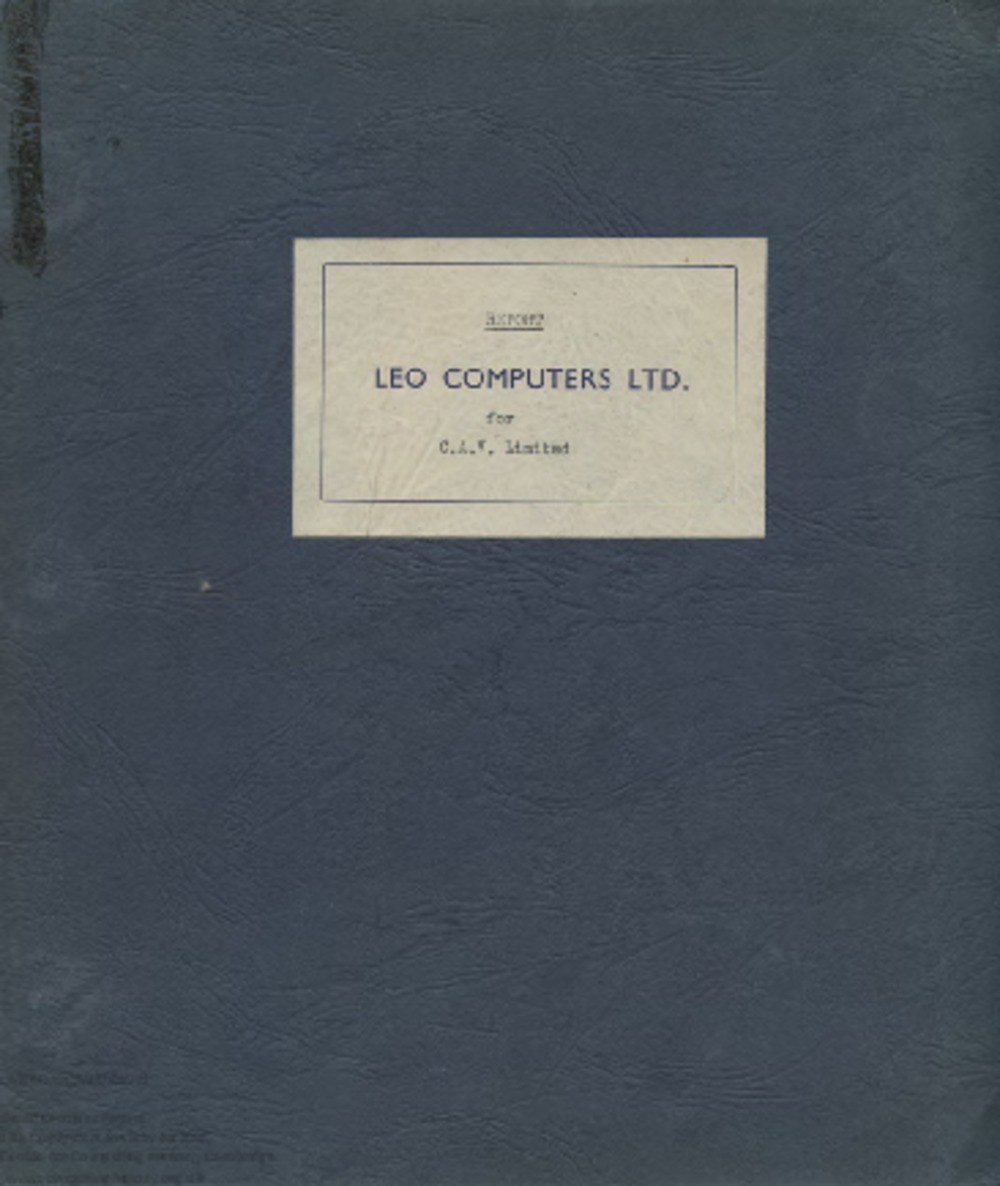|
Specification/feasibility study for a LEO computer (LEO II) at CAV Ltd, written for the clients as a quotation document. Later annotations in pencil adapt the text into a similar document aimed at Kodak Ltd.
Contents:
I. Equipment, Costs and Hire Charges
II. Estimated Times of Jobs and Data Preparation
III. Staffing and Training
IV. Consultancy and Programming Service
V. Accommodation and General Details of LEO II
Research comments: It is interesting to note that CAV Ltd purchased a LEO machine (LEO III/5) in 1963, even though this report suggests that installation of a rented LEO could take place within 18 months. Kodak used the LEO bureau service for many years.
CAV Ltd is the engineering company C.A. Vandervell & Co., that originally produced electric storage batteries and equipment and subsequently fuel injection technologies, becoming part of Lucas Industries. The report suggests that a LEO computer would be useful for payroll (at CAV's Acton, Rochester and Sudbury sites), as well as for tasks relating to stock and inventory control and costing. The weekly payroll would take 5.5 hours to run, the report states, production planning and control would take almost 7 hours each week, and maintenance and tool stock control would take over 3 hours. In addition a range of 4-weekly tasks would take 14 hours each time. In addition to run time, data preparation (perforating, checking and card punching) is all allowed for and would need 16 clerks to do!
As well as clerks the report states that computer operators and maintenance staff would be needed involving a single manager, 3 operators, 1 assistant operator, a 'Job Assembly Assistant', 4 engineers and a valve tester all working on a single shift. LEO Computers would train them all. Programmers required a 5 week training course, followed by 9 months of theoretical and practical training. The first 6 months of training would be spent at LEO Computers. The operators would start with the same 5-week course as the Programmers, followed by 3 months of operating experience at LEO Computers. For the engineers, a preliminary 3 months' training was anticipated for those with no electronic qualifications but who had previously reached HNC level of technical education, followed by 9 months' formal training, with the first 6 spent at LEO Computers. Additional engineers would need to be trained to maintain the auxiliary equipment (Input, output, comparators) for 2 months. LEO Computers also ran 1 week Executive courses for staff who needed oversight of the computer and 5 week programming courses for other staff.
The report also sets out the physical space required for a LEO II machine; 60ft (18.3m) x25ft (7.6m) for the machine itself plus additional space for staff and a workshop for the engineers. The machine would need to sit on an "electrically insulated floor" of wood, cork or linoleum while being capable of bearing 100lbs (45kg) per sqft.
Other details are specified on the power requirements as well as stating on page 27 that LEO II:
- uses binary,
- the pulse rate is 525 kilocycles,
- the short word length is 18 bits + sign (40 microseconds) and the long 38 bits + sign (80 microseconds),
- the instruction type is single address (19 bits),
- uses mercury delay line storage as the "quick access store" capable of 2048 short words with 160 microseconds access and immediate access for 14 words,
- uses magnetic drums as auxiliary storage capable of 8192 words per drum (average access 6 milliseconds),
- has an arithmetic unit with 14 registers,
- has 3 channel input (punched card at 200 cards per minute, paper tape at 200 characters per second and up to 8 decks of magnetic tape at 100 inches per second),
- has 3 channel output (printers (Hollerith/Bull/Powers), Hollerith card punch and magnetic tape at 100 inches per second),
- can drive auxiliary printing via a punched card operated electric typewriter (7 characters per second),
- automatic conversion and reconversion between binary, decimal and sterling (pre-decimalisation UK currency),
- has buffer storage to allow simultaneous input, output and computation, and transfer to and from magnetic drums and tapes,
- has marginal checking facilities.
The level of detail in this report overall is extraordinary but is very typical of how LEO Computers approached the work they did for their customers.
Referring to the computer as the LEOmatic Office is also interesting. (LM)
In June 2020, Frank Land commented: I had not seen that proposal to CAV since it was issued, and I don’t remember the use of the name LEOMATIC Office. But CAV had been one of the earliest LEO customers using LEO I and later LEO II as a bureau for technical calculations. As I remember it they had two programmers Fred Bishop and Eric Kavanagh. By the time LEO II became available for sale CAV were interested in acquiring one for themselves. One of their top executives, Wilkinson had great ideas of using computers to transform the CAV business and he started the negotiations that led to the comprehensive sales document. But it was not till later that it led to the sale of a LEO III. (FL)
Date : 22nd January 1958
Physical Description : 1 item (27 pages), paper; typescript with manuscript annotations
Provenance :
From David Caminer's papers.
Archive References : CMLEO/DC/WF/CAV/1
, DTC/2/4
, DCMLEO20200528001-027
This exhibit has a reference ID of CH58903. Please quote this reference ID in any communication with the Centre for Computing History.
|
|


This document has been scanned and is available to view online.
Copyright
Lyons copyright
File Size: 2.18 MB
|











